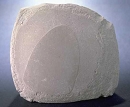
|
| Illite |
Chemical
Formula |
(K,H3O)(Al,Mg,Fe)2(Si,Al)4O10[(OH)2,(H2O)] |
Species |
Silicates |
Crystal
System |
Monoclinic |
Mohs
Scale |
1-2 |
Specific
Gravity |
2.6-2.9 |
Color |
Grey-white to silvery-white, greenish-gray |
Streak |
white |
Luster |
Pearly |
Refractive
Index |
n = 1.535 - 1.570 n = 1.555 - 1.600 n = 1.565 - 1.605 |
Diaphaneity |
Translucent |
Cleavage |
PerfectPerfect on . |
Fracture |
Micaceous |
| Crystal Habit:Micaceous aggregates |
| Geological Setting:Found in a wide variety of environments, the materials of this series form by either weathering or hydrothermal alteration of muscovite-phengite; but some is authigenic or could be derived from alteration of K-feldspars or recrystallization of smectites. Common in sediments, clays, marls, shales and some slates. Interstratified illite-smectite converts to illite at depths. |
Illite is a non-expanding, clay-sized, micaceous mineral. Illite is a phyllosilicate or layered alumino-silicate. Its structure is constituted by the repetition of tetrahedron – octahedron – tetrahedron (TOT) layers. The interlayer space is mainly occupied by poorly hydrated potassium cations responsible for the absence of swelling. Structurally illite is quite similar to muscovite with slightly more silicon, magnesium, iron, and water and slightly less tetrahedral aluminium and interlayer potassium. The chemical formula is given as (K,H
3O)(Al,Mg,Fe)
2(Si,Al)
4O
10[(OH)
2,(H
2O)], but there is considerable ion substitution. It occurs as aggregates of small monoclinic grey to white crystals. Due to the small size, positive identification usually requires x-ray diffraction or SEM-EDS (automated mineralogy) analysis. Illite occurs as an alteration product of muscovite and feldspar in weathering and hydrothermal environments; it may be a component of sericite. It is common in sediments, soils, and argillaceous sedimentary rocks as well as in some low grade metamorphic rocks. The iron rich member of the illite group, glauconite, in sediments can be differentiated by x-ray analysis.
The cation exchange capacity (CEC) of illite is smaller than that of smectite but higher than that of kaolinite, typically around 20 – 30 meq/100 g.
Illite was first described for occurrences in the Maquoketa shale in Calhoun County, Illinois, USA, in 1937. The name was derived from its type location in Illinois.
Illite is also called hydromica or hydromuscovite. Brammallite is a sodium rich analogue. Avalite is a chromium bearing variety which has been described form Mt. Avala, Belgrade, Serbia.
Illite crystallinity
The crystallinity of illite has been used as an indicator of metamorphic grade in clay-bearing rocks metamorphosed under conditions between diagenesis and low-grade metamorphism. With increasing temperature, illite is thought to undergo a transformation into muscovite.


 YueGongAnBei 44051102000467
YueGongAnBei 44051102000467


 |
|